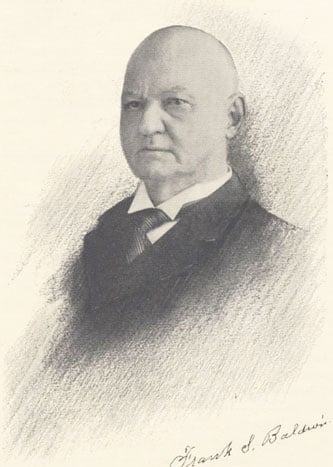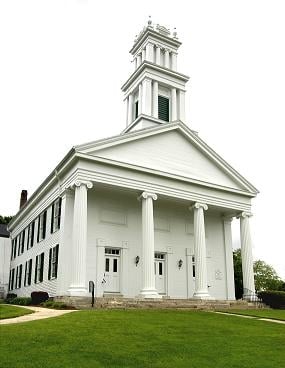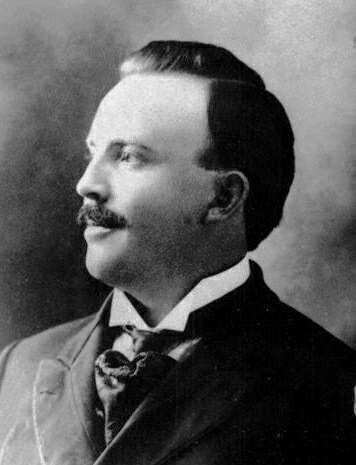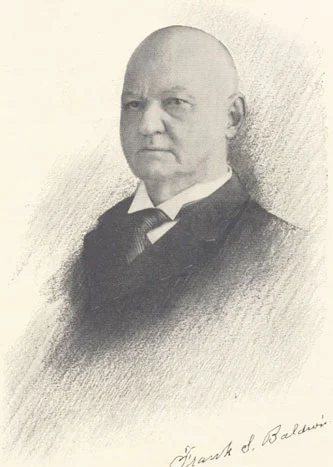
Frank Baldwin

Early Life and Education
Frank Stephen Baldwin was born on 10 April 1838, in New Hartford, Connecticut, in the family of master builder Stephen Baldwin, owner of an architectural business. Although technically not an architect, Stephen Baldwin was a well-known professional, known for building several structures in the region.
Frank Baldwin devoted most of his life to inventing and manufacturing machines, especially calculating devices, and was granted several patents. In 1872 Baldwin married Mary K. Denniston (1848-1928) of Williamsport, Pennsylvania. They had 6 children: Frank Pardee Baldwin (1873–1946), Emma Virginia Baldwin (1877–1952), Eugene Denniston Baldwin (1880–?), George Howard Baldwin (1890–1950), Lillian Isabel Baldwin (1886–1916) and Blanche Baker Baldwin (1891–1969).
There is a comprehensive interview of Frank Baldwin from 1919, in which he describes the significant moments of his life. In that, he describes his childhood, education, and career in detail.
His family moved to Nunda, Livingston County, New York when he was only two years old. There he attended the first free school system created by the State of New York. He showed promise at a young age and surprised all his teachers by memorizing the decimal of Pi to 128 places.
After graduating from the Nunda Institute he enrolled at the Union College. However, his education was cut short due to his father becoming an invalid due to an accident. He had to take over the management of his father’s architectural business which officially put an end to his education.
Career
He started experimenting with various ideas and devices and in 1855 applied for his first ever patent for an arrowhead self-couple used in railroad cars. However, it was denied, and that denial spurred him on as he became more dedicated to becoming a successful inventor.
In 1860 he helped one of his family members register for a patent for a corn planter. He tried to join the Civil War, but due to stress, he had to resign after three months. In 1869 he got a job as a manager of a mill in St. Louis and started devoting more of his time to working on his own ideas and innovations.
Around this time, he invented a number of devices, a) an Anemometer, that recorded the direction of the wind, b) a step device for street cars that recorded the number of passengers being carried, c) a street indicator that was geared with an axle that showed each street in succession, with the help of an illuminated box.

Frank Baldwin in 1870
He also invented the “Recording Lumber Measure” which he successfully patented. This machine could simultaneously measure and record four different kinds of lumber automatically. According to him, this was a device that started him on the path of thinking about computing machines and the beginning of the Monroe.
After encountering the Thomas type of calculating machine, created by C. X. Thomas of Colmar in 1820, he thought about increasing the efficiency by adding 8 more cylinders to the machine. In 1874, he filed and was granted the patent for ‘Arithmometer’ the first calculator sold in the USA. Both of these machines were displayed at the Franklin Institute, Philadelphia, and got the John Scott Medal for meritorious invention.
He partnered with Reliance Machine Works in Philadelphia to manufacture his calculating devices at a larger scale while he took over the sales department. He found success in New York and Washington, however, it was not as profitable as he had hoped and he had to wind down and return to St. Louis. It was around this time his device fell into the hands of Mr. Ohdner, a Swedish national who patented the product in Europe.
In 1900, he got a patent for the Baldwin Computing Engine, the machine that could multiply or divide with the stroke of a button. In 1908, he got the patent for the Baldwin Recording Calculator. He met Mr. Jay R. Monroe in 1911, and the association led to the creation of the Monroe High Speed Adding-Calculator.
Death
Frank Baldwin died on April 8, 1925, in a private hospital in Morristown, New Jersey, following an operation, within two days of reaching his 87th birthday. Until the last day of his life, his mind was clear and keen, and his interest in his family and the things about him was just as pronounced as ever.
Besides the several patents of calculating devices, Baldwin is a holder of several other patents for machines — e.g. for cement or mortar mixes (1891) and roundabout (carousel) in 1892.
The image featured at the top of this post is ©Unknown author / public domain


